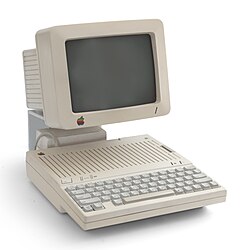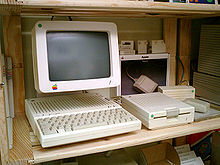Apple IIc
| Apple IIc | |
|---|---|

|
|
| Manufacturer | Apple |
| Presented | April 1984 |
| Discontinued | August 1988 |
| Recommended sales price | US $ 1300 |
| CPU | 65C02, 1.020 MHz |
| R.A.M. | 128 KiB (max. 1.125 MiB) |
| OS | ProDOS |
The Apple IIc was the fourth model in the Apple II line and was Apple's first portable computer, with the letter c standing for compact . It was equipped with a MOS-65C02 processor with a clock frequency of 1.02 MHz and weighed 3.4 kilograms.
The Apple IIc + was introduced in 1988 and was only sold in the US. In contrast to the IIc, it had a 3.5 "drive and a 65C02 processor with a clock frequency of 4 MHz. Due to the comparatively low price of 675 US dollars , the model sold very well.
history
The Apple IIc was launched in April 1984 as part of an event called Apple Forever . The title of this event was understood as Apple's commitment to the Apple II series, which will not be dropped in favor of the recently introduced Macintosh .
Since the Apple IIc essentially corresponded to an Apple IIe with a collection of common additional plug-in cards, it was not viewed as a successor, but as a complementary portable version; the IIe continued to be built and outlived the IIc by a few years at the end.
The computer introduced Apple's Snow White design language with an elegant and sleek look for its time, which soon became the standard for most Apple computers and their accessories for nearly a decade.
Although the Apple IIc was relatively light and compact, it was not considered truly portable because it had neither a battery nor a built-in display.
properties
Improvements over the IIe
Technically, from the user's point of view, the Apple IIc was an Apple IIe in a smaller case, with the exception of a few minor improvements that did not significantly affect compatibility with the original IIe.
- It was WDCS 65C02 instead of the MOS 6502 processor. It offered 27 new commands and a lower power consumption.
- The new ROM firmware made it possible to work with lower case letters in Applesoft BASIC, improved the support for 80-column monitors and fixed some bugs from the previous version.
- "Mousetext": The text character set was extended by 32 graphic character symbols which, if they were arranged correctly next to one another , could display simple icons , windows and menus in text mode , similar to IBM's code page 437 .
Side note: A year later, all of these features could also be used on the IIe; This was made possible by an upgrade called Enhanced IIe .
Internally, however, the computer worked significantly differently than the Apple IIe in some respects, for example it contained a ROM that was twice as large and much more complex, and interrupts were used for the first time in the Apple II series .
Built-in expansion cards and interfaces
Five common expansion cards have been integrated into the main board of the IIc. These included:
- A combined memory expansion and graphics card that could display 80 columns
- Two Apple Super Serial Cards
- A mouse card
- A controller card for floppy disk drives.
The Apple IIc had 128 KiB RAM , 80-column display, and the so-called double high-resolution graphics with 560 × 192 pixels as standard on board, in contrast to its predecessor IIe, but the possibility of installing all sorts of additional expansion cards was no longer available, as none real slots were more available. The integrated cards were placed on virtual slots so that software from earlier Apple II models could recognize the cards without additional modifications. The controller card for floppy disk drives is interesting; this was scaled down to a single chip called the “IWM”. The abbreviation stood for Integrated Wozniak Machine.
The interfaces were on the back of the computer. The DE9 interface for the joystick was also used as a connector for the mouse and was compatible with the mice from the Lisa and early Macintosh models. Two serial interfaces were also available (two so that a printer and a modem could be connected simultaneously), as well as an interface for a second 5.25 "floppy disk drive (later 3.5" and hard disks could also be connected via it). There was also a more complex video interface for additional adapters, but this connection could only generate rudimentary signals; himself he was not able to generate a video signal. Apple manufactured an LC display and an RF modulator for this output; the modulator was later shipped with the IIc. The composite video output of the earlier Apple II models remained, but the internal DIP-16 game port and connection for cassette players have been removed. The power supply connection was connected to internal voltage converters and therefore only required a single external voltage; this enabled the IIc to be operated on a car battery using a simple adapter cable.
Technical specifications
CPU
- 65C02 with 1.020 MHz clock frequency
- 8-bit data bus
random access memory
- 128 KiB RAM built in.
- 32 KiB ROM built in (Original: 16 KiB)
- Expandable (from motherboard version "ROM 3") with up to 1 MiB RAM, maximum expansion therefore 1.125 MiB
Mass storage
- A slim-line 5.25-inch floppy disk drive installed, single-sided, 140 KiB.
- Connection for another 5.25 "drive and / or (from motherboard version" ROM 1 ") a 3.5" drive (double-sided, 800 KiB).
BASIC and operating system
- Applesoft BASIC (built-in as ROM)
- Apple ProDOS (supplied on floppy disk)
- Apple DOS (to be purchased separately if required)
graphic
- Text modes: 40 and 80 columns / 24 lines, monochrome white on black
- Low-Resolution: 40 × 48 (15 colors) (graphic, low resolution)
- High-Resolution: 280 × 192 (6 colors) (graphic, high resolution) *
- Double-Low-Resolution: 80 × 48 (15 colors) (graphic, low resolution doubled)
- Double-High-Resolution: 560 × 192 (15 colors) (graphic, high resolution doubled) *
* The horizontal resolution was halved when displaying in color.
The text modes could be mixed with the graphic modes; the bottom 4 lines of text were displayed and graphics above.
Audio
- Built-in loudspeaker, "1-bit toggling"
- Adjustable volume
Internal connections
- Connection for memory expansion cards (34-pin) (only on ROM 3 or later motherboards)
Internal special controller
- IWM (Integrated Wozniak Machine) for floppy disk drives
- Two 6551 ACIA chips for serial I / O
External connections
- Joystick / mouse (DE-9 socket)
- Printer, first serial port (DIN-5 socket)
- Modem, second serial port (DIN-5 socket)
- Video expansion port (D-15 socket)
- SmartPort floppy disk drive (D-19 socket)
- Operating voltage (12 volts DC) (DIN-7 plug)
- NTSC composite video output (RCA socket)
- Audio-out (3.5 mm jack socket)
Revisions
The revision number of the Apple IIc can be PRINT PEEK(64447)requested using the BASIC command .
Original version (ROM revision '255')
This was the first model. This firmware is the only one with a size of only 16 KiB, all later versions are 32 KiB.
Serial port timing fix
The first series could not exactly adhere to the baud rates at the serial ports, which often caused transmission errors, especially with fast devices. The first revision fixed this bug. The ROM remained unchanged, which is why there was no new revision number.
UniDisk 3.5 support (ROM revision '0')
This revision supported the use of a 3.5-inch external floppy drive with 800 KiB of storage capacity in addition to the 5.25-inch model. The "UniDisk 3.5" drive had its own processor because the 1 MHz processor of the IIc was too slow to process the data from the 3.5 "drives, which is much faster than the 5.25" drives decode. The previous version could be brought up to date with a new firmware chip.
Memory Expansion IIc (ROM revision '3')
This revision could be expanded internally to 1.125 MiB memory. From a software point of view, the memory expansion was compatible with the “Apple II Memory Expansion Card” for the Apple IIe. Since the main board was significantly changed, it was not possible to upgrade older revisions to this version by exchanging firmware, but only by changing the main board.
Memory Expansion IIc, fix (ROM revision '4')
This version only fixed some relatively obscure bugs in the firmware. Revision 3 could be upgraded to this version by exchanging firmware.
IIc + (ROM revision '5')
The processor of this serial fastest of all Apple II models ran at four times the speed (can be switched off), the internal drive was a 3.5-inch model. The color of the computer was changed to gray, the power supply was now permanently installed. Simpler and cheaper 3.5-inch drives without their own processor could now also be connected, as were common on the Apple IIgs . This model was officially only sold in the USA and only exists with an American keyboard, 110-volt power supply and NTSC video standard. It was not possible to upgrade older models to this status.
Web links
- PCB photographs
- Presentation in c't issue 6 from 1984
Individual evidence
- ↑ Apple IIc - 1984. Retrieved April 28, 2019 (English).

